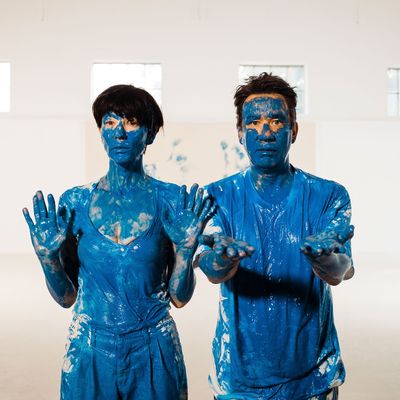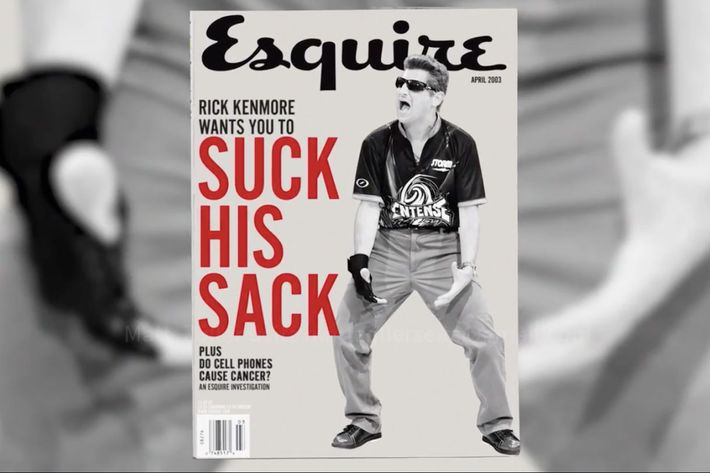
The third season of IFC’s obsessive comedy series Documentary Now! is filled with grace notes. My favorite is a moment in “Searching for Gary Larson: A Love Letter from the Far Side.” The hero, Bradley Adams (played by series co-creator Fred Armisen), is one of those questing pilgrims at the gooey center of a “personal journey” movie, but he seems manic and desperate from frame one, and very soon we learn he abandoned his wife and newborn child to drive to Seattle and try to surprise the creator of The Far Side. Bradley is clearly in psychic turmoil, though where he stands on the continuum between midlife crisis and psychotic break is hard to say. Then comes a moment of wounding disappointment, after which Bradley turns to the camera and asks, “Hey… dad…?”
Until that point, we had no idea that the main character’s father was the one recording this fool’s odyssey. We barely hear from Bradley’s dad after that, but the moment raises genuinely uncomfortable questions precisely because it feels tossed-off, then evaded—as if the “movie” itself has made a Freudian slip, then stammered past it. Are we watching family history repeat itself, the father enabling and ruining the son? Nobody mentions the hero’s mother. Did she leave when Bradley was a boy, after enduring shenanigans like the ones pictured here?
There’s always a story behind the story on Documentary Now!, plus one or more layers of subtext under the text, plus implied questions of presumed and actual authorship and the relationship between spectator and image. Armisen, co-creators Bill Hader and Seth Meyers, frequent contributor John Mulaney, and the other regulars are all veteran SNL writer-performers, at ease slipping into the psyches (and wigs, and facial prosthetics) of misfits, dreamers, and foils imagined in the scripts. Documentary Now!’s fourth creator, Rhys Thomas, and the series’ regular director-cinematographer Alex Buono are SNL chameleons of a different kind, specializing in fake trailers, ads, and the like: They reproduce the look and feel of documentaries from specific eras and schools, down to the camera style, the editing, the relative clarity or muddiness of the soundtrack, even the density of “film grain” (the entire series is shot digitally). At its worst—which is still a cut above almost everything else on television—the series is filmmaking karaoke practiced at a high level. But at its best, it goes beyond stylistic gamesmanship and creates stories of people who have no idea how ridiculous and tragic they are, and who are unprepared for the humiliations life has in store for them, especially when somebody is pointing a camera at them and telling them, perhaps for the first time in their life, that their story is important and deserves to be told.
When you look back on the best of Documentary Now!, it’s the characters you remember. This new season—the first in three years, owing to the creators’ increasingly busy schedules—feels like an evolution of sorts, largely purging itself of pure delight in imitation/parody (as in an SNL sketch) and treating the exceptional writing, acting, and filmmaking as a way to portray and explore these strange and mesmerizing individuals. Although some of the core cast members appear onscreen (and Armisen plays multiple roles), this season feels like more of a traditional anthology with a big ensemble than a showcase for the versatility of a handful. The impressive cast includes Cate Blanchett, Natasha Lyonne, Owen Wilson, Michael Keaton, Necar Zadegan, Paul Bright, Gary Kraus, Connie Chung, Kevin Dunn, Tim Robinson, and Michael C. Hall.
Some episodes seem to come at the characters from outside-in (particularly the Gary Larson episode, which holds its hero at some remove, and the season-opening two-parter starring Wilson as a cult leader, Zadegan as his lieutenant, and Keaton and Kraus as FBI agents). Others are more straightforwardly observational, like “Original Cast Album: Co-Op.” And there are episodes that manage to be outside and inside at the same time. “Long Gone,” a dreamy, monochrome spoof of Let’s Get Lost, the 1988 Bruce Weber documentary, stars Armisen as a jazz guitarist and womanizing brooder who gets mixed up with an Eastern European dictator, and Lyonne as his jazz singer ex-wife; the piece allows the main character, an unrepentant jerk, to point out the contrived phoniness of the movie he’s at the center of, even as we’re thinking that it captures an undeniable truth about why he’s so miserable, and why he makes others miserable, and why they let him make them all miserable. To varying degrees, and in remarkably different ways, every episode in season three strikes a perfect balance between formalism and humanism. You marvel at the technique, yet the characters are not paper targets. They have a pulse. They feel disappointment and pain. You see yourselves in them.
The first Documentary Now! episode to hit the sweet spot was season one’s “Kunuk Uncovered,” a spoof of 1922’s Nanook of the North—the first blockbuster nonfiction movie, and largely fabricated. Armisen plays an Inuit tribesman who’s pressured by a visiting white filmmaker to pretend that he still lives an authentic 19th-century lifestyle. Frustrated by the director’s thickheaded primitivism, Kunuk seizes control of the production, embraces his own stereotype in the name of art and opportunity, and becomes the uncredited true director of the movie, inventing filmmaking processes that he will never get credit for because of his race. (By the end, he seems as great an innovator as D.W. Griffith.) A high point of season two was “Mr. Runner Up: My Life as an Oscar Bridesmaid,” a spoof of the Robert Evans documentary The Kid Stays in the Picture that showed how powerful showbiz figures can game the system and lure younger filmmakers into making movies that amount to feature-length ads for their self-created legends. “Mr. Runner Up” sees through the oblivious egotism of its main character, Jerry Wallach (Hader), where its inspiration was content to let Evans be a huckster.
The series takes care to get microscopic aesthetic details right, sacrificing them only in favor of jokes. Some of the touches go beyond period-accuracy and into Mad Men-style cultural anthropology. Look, for example, at the way the sports documentary spoof “Any Given Saturday Afternoon” mimics the style of a hyper-specific subgenre, the early-aughts “competition” doc (see: A League of Ordinary Gentlemen, Spellbound, Mad Hot Ballroom, King of Kong, and Air Guitar Nation). The exactitude extends to throwaway details, like the leader of a bowler’s league (Kevin Dunn) confirming the insular nature of his sport by referring to NFL stars “Walter Payton and Joe Montan [sic],” or the reference to the PBL being purchased in 2002 by “two former Pets.com executives” (it’s the “former” that makes it art). Some of the sight gags are cultural rabbit holes in themselves, like the bit where the self-styled “bad boy of bowling,” Rick Kenmore (Tim Robinson), a John McEnroe manque, mints his catchphrase “Suck my sack!” The episode cuts to an Esquire magazine with a cover story on Kenmore; not only is Esquire exactly the magazine that would’ve commissioned a thumbsucker on a Kenmore-like figure (from the 1960s onward, the magazine prided itself on long features, exploring the cultural significance of male sports rebels), the wording of the cover line is spot-on—and right beneath it is a tease to another story, “Do Cell Phones Cause Cancer?”, a question everyone was asking at that point.

Even more meticulous is “Original Cast Album: Co-Op,” a spoof of D.A. Pennebaker’s 1970 Original Cast Album: Company, about the recording of Stephen Sondheim’s classic. Like Documentary Now!’s other spoofs of films from the “direct cinema” school—including season one’s “Sandy Passage,” a sendup of Grey Gardens, and season two’s “Globesman,” a riff on Salesman—this one is super-fussy about how it looks and moves, which is absolutely a good thing. Aficionados of documentary camera style (all 12 of us) will notice that it feels like Pennebaker rather than the Maysles Brothers (who did Grey Gardens and Salesman): It’s plainer and more efficient, less searching and poetic. The music, by Eli Bolin, Meyers, and Mulaney (who plays a chain-smoking, imperious, vaguely Sondheim-ish composer with a shaggy ‘70s mane) is just as true to its inspiration, sounding like a delusional Sondheim imitator’s attempt to channel the master.
But here, as in some other Documentary Now! episodes, the fanatical attention to form isn’t displayed like a ship in a bottle, hermetically sealed. It’s in service to emotional content that creeps up on you—at times affecting you as a real documentary might. The performers don’t act like they’re in on the joke; nor, for that matter, do they behave as if they view this material as anything other than the chance of a lifetime, a shot at immortality that nobody can take away from them. A remarkable ensemble has gathered in the Co-op recording studio: musical actors played by Alex Brightman, Renee Elise Goldsberry, Richard Kind, Paula Pell, Merideth Kaye Clark, Jesse Cromer, Alec Cameron Lugo, Bobbi MacKenzie, Norman Wilson and Leah Yorkston. And the fact that they are recording the album at all, after learning that Co-op closed after one night due to poisonous reviews, gives the exercise a poignant, even heroic quality. It’s a textbook example of The Show Must Go On.
Best this season, and maybe the peak of the series, is “Isabella Barta: Waiting for the Artist,” starring Blanchett as the title character, a legendary Hungarian performance artist and seemingly the hardest-working and most self-flagellating woman on the planet, and Armisen as her sometime boyfriend Dimo van Omen, a lazy, smug dandy. At first the episode seems to be making fun of performance art in general, a cheap trope with a long, white beard.
But quite soon you realize that the series respects Isabella as a true artist (though a pretentious and self-involved one who’s constantly flirting with self-caricature). She explores her emotional interior, challenges herself, and feels things deeply; Dimo, on the other hand, is an opportunist who blatantly rips off Isabella and, by his own admission, avoids anything resembling real effort. Yet Dimo is taken just as seriously by the art world (or so it seems), and his ill-fated relationship with Isabella is depicted as a deeply damaging experience that she spent years trying to recover from. Even as this episode asks legitimate questions about sexism in the art world, and how women and men experience the pain of love and loss, it plays games with our perceptions, asking how much all these characters know themselves, and how much we (and by extension the filmmakers) know about them. The triumph of “Waiting on the Artist” is the triumph of Documentary Now! as a whole: It’s a display of pure artifice that somehow manages to find a core of authenticity, and makes us care for people that we would dismiss as jokes if their emotions didn’t feel real.


